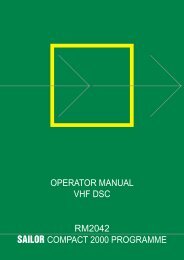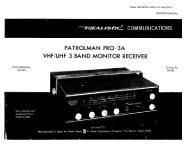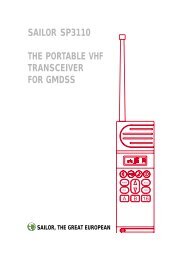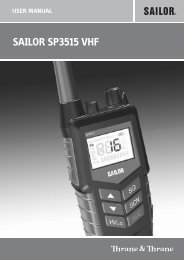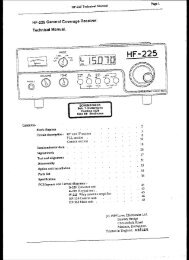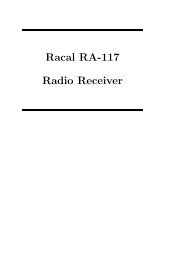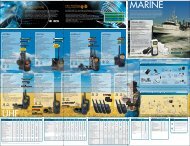MFJ-8100K Manual
MFJ-8100K Manual
MFJ-8100K Manual
You also want an ePaper? Increase the reach of your titles
YUMPU automatically turns print PDFs into web optimized ePapers that Google loves.
The result, we think, is a receiver design which bridges the classic simplicity of<br />
regeneration to the performance demands of the 1990's. Here's how we did it:<br />
In brief, the circuit uses RF regeneration and high levels of DC feedback. Notice that the<br />
antenna is coupled directly to the source of RF amplifier FET Q3 rather than through the<br />
L-C tuning network. Direct coupling of the drains of Q1 and Q3 isolates the L-C circuit<br />
from the antenna input, enhancing stability and greatly minimizing RF oscillator output to<br />
the antenna. Such RFI has been a serious problem in traditional regenerative circuits<br />
which permitted the oscillating detector to behave as an unstable but potent QRP<br />
transmitter.<br />
R4 reduces the Q of L1 (10 µH) for smoother regeneration. The SW1 bandswitch selects<br />
a combination of simple inductors. For example, the total inductance for Band A is<br />
L1+L2+L3+L4+L5. The inductance for Band E is only L5. And so forth.<br />
Air variable C1 uses its 50 pF range and mechanical vernier reduction to provide smooth<br />
"bandspread'' in parallel with C3 and trimmer C5 which perform the traditional "bandset''<br />
function.<br />
Trimmer pot R20 ensures adjustability for smooth regeneration over all tuning ranges,<br />
regardless of individual FET characteristics.<br />
C17, C9, C10 and R9 form a low pass filter to block RF from the audio amplifier and<br />
provide basic audio filtering.<br />
Volume Control R2 varies OUTPUT rather than low-level input to the LM386 audio<br />
amplifier. This approach further isolates the RF stages from variations in the audio<br />
section.<br />
The LM386 (IC1) circuitry employs all recommended options for maximum gain and<br />
protection from self-oscillation.<br />
To prolong useful battery life, R13 limits current draw by the LED (CR1) to minimum<br />
reasonable visibility as an on/off indicator.<br />
7




